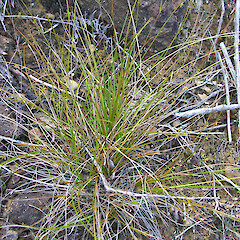Carex devia
Common name
an ultramafic sedge
Synonyms
None
Family
Cyperaceae
Flora category
Vascular – Native
Endemic taxon
Yes
Endemic genus
No
Endemic family
No
Structural class
Sedges
NVS code
The National Vegetation Survey (NVS) Databank is a physical archive and electronic databank containing records of over 94,000 vegetation survey plots - including data from over 19,000 permanent plots. NVS maintains a standard set of species code abbreviations that correspond to standard scientific plant names from the Ngä Tipu o Aotearoa - New Zealand Plants database.
CARDEV
Chromosome number
2n = c.70-72
Current conservation status
The conservation status of all known New Zealand vascular plant taxa at the rank of species and below were reassessed in 2017 using the New Zealand Threat Classification System (NZTCS) – more information about this can be found on the NZTCS website. This report includes a statistical summary and brief notes on changes since 2012 and replaces all previous NZTCS lists for vascular plants.
Please note, threat classifications are often suggested by authors when publications fall between NZTCS assessment periods – an interim threat classification status has not been assessed by the NZTCS panel.
- Conservation status of New Zealand indigenous vascular plants, 2017 . 2018. Peter J. de Lange, Jeremy R. Rolfe, John W. Barkla, Shannel P. Courtney, Paul D. Champion, Leon R. Perrie, Sarah M. Beadel, Kerry A. Ford, Ilse Breitwieser, Ines Schönberger, Rowan Hindmarsh-Walls, Peter B. Heenan and Kate Ladley. Department of Conservation. Source: NZTCS and licensed by DOC for reuse under the Creative Commons Attribution 4.0 International licence.
2017 | At Risk – Naturally Uncommon | Qualifiers: RR
Previous conservation statuses
2012 | At Risk – Naturally Uncommon | Qualifiers: RR
2009 | At Risk – Naturally Uncommon
2004 | Range Restricted
Distribution
Endemic. South Island, Nelson where confined to ultramafic rocks (Mt Dun, Red Hills and Upper Takaka River (Asbestos Hut area).
Habitat
A common species of open ultramafic scree, boulder field, tussock grassland and under low lying scrub. Also common on old mine workings in the upper Takaka and at Dun Mountain.
Detailed description
Rather loosely caespitose, reddish green to yellow-green sedge of ultramafic shrubland, tussock grassland, scree, pavement and boulder field. Culms 70–750–(900) × 1 mm, usually much > leaves, subtrigonous, glabrous or finely scabrid; basal sheaths brown, dark brown, to almost charcoal black, occasionally red-tinged. Leaves 70–300 × 1.5–2.5 mm, usually crowded at base of culm, channeled, often involute, rather stiff, margins scabrid. Spikes 2–4, ± distant, sessile usually with the lower 1–2 shortly pedunculate; terminal 1–2 spikes male, these 1.5–3 mm diameter, typically clavate, rarely with a few female flowers near the base, female spikes 1–30 × 5 mm. Glumes (excluding awn) just < utricles in length, ovate, acute, sometimes emarginated, coriaceous, red-purple or red-brown with a green midrib prolonged to a hispid awn or varying length. Utricles 3 × 1.5 mm, unequal, biconvex to plano-convex, ellipsoid, light brown at base, darker brown above, distinctly nerved, abruptly narrowed to a 0.2–0.5 mm beak, this deeply cleft with divergent teeth, crura scabrid, utricle other glabrous, stipe 0.5 mm. Stigmas 2. Nut 1.8–1.9 mm, biconvex, oblong.
Similar taxa
The ultramafic sister species of Carex flagellifera Colenso, from which it differs by the rather leathery reddish-green rather softer, yellow-green to green leaves, close-set rather than distant, shorter, broader female spikes, clavate rather than gracile linear terminal male spikes, and distinctly rather than faintly nerved completely red-purple or red-brown rather than bicoloured (light brown basally dark brown terminally) utricles. In some situations the fruiting culms may elongate up to 2 m from the parent plant. The two species have distinctly different chromosome numbers, 2n = c.58 in C. flagellifera, 2n = c.70-72 in C. devia.
Flowering
September–December
Fruiting
September–June
Life cycle
Nuts surrounded by inflated utricles are dispersed by granivory and wind (Thorsen et al., 2009).
Propagation technique
Although this is an ultramafic endemic, it is easily grown in most soils and situations. Favouring free draining sites and full sun it is an attractive alternative to the more commonly cultivated Carex flagellifera Colenso and C. testacea Sol. ex Boott in Hook.f. Can be propagated by division of whole plants and/or by sowing fresh seed.
Threats
A local, range-restricted endemic, abundant within the ultramafic communities it favours.
Etymology
carex: Latin name for a species of sedge, now applied to the whole group.
Where To Buy
Not commercially available
Attribution
Description adapted from Moore and Edgar (1970)
References and further reading
Moore LB, Edgar E. 1970. Flora of New Zealand, Volume II. Indigenous Tracheophyta: Monocotyledones except Gramineae. Government Printer, Wellington, NZ. 354 p.
Thorsen MJ, Dickinson KJM, Seddon PJ. 2009. Seed dispersal systems in the New Zealand flora. Perspectives in Plant Ecology, Evolution and Systematics 11: 285–309.













